9075 AN INTERESTING BURR MULBERRY OR ELM AND BRASS INLAID SOFA TABLE English. First Quarter Of The Nineteenth Century. Measurements: Height: 28 3/4″ (73 cm) Width: 44″ (112 cm) Width when extended: 62″ (157.5 cm) Depth: 24 1/2″ (62 cm)
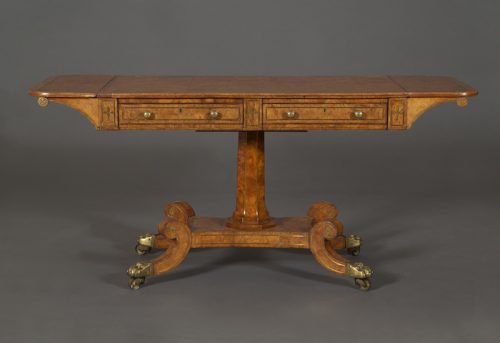
Research
Of burr mulberry or burr elm with brass inlay. The rectangular top, flanked by fall flaps, with a brass line border cornered by fleur-de-lis, the frieze fitted with two short drawers mounted with old but replaced brass handles, the drawers flanked by panels filled with fleur-de-lis, the frieze fully dummied to the reverse, the whole raised on a faceted flared stem, the quatreform plinth raised on four scrolling paneled feet inlaid with brass stars and terminating in paw feet raised on castors. Some minor repairs.
Provenance:
A Belgian private collection.
The original sofa tables of the late 18th and early 19th centuries were a development of the Pembroke table, which had a long central drawer and hinged flaps on either side. It’s name, according to Thomas Sheraton, came from “the lady who first gave orders for one of them, and who probably gave the first idea of such a table to the workmen…,”1 possibly the Countess of Pembroke (1737-1831).
Meant to be placed before a sofa, “the ladies chiefly [occupied] them to write, draw, or read upon.”2 Because of their versatility, they were recommended as “suitable for a drawing-room, breakfast parlour or library.”3 Sofa tables characteristically have two drawers in the frieze and decorative brackets at the sides, as in the case of the present table, to support the hinged flaps.
The table is unusually veneered entirely in burr mulberry or elm. The use of indigenous woods, as opposed to mahogany and rosewood, at this date seems first to have been championed by George Bullock. For this he was praised by his contemporaries who proclaimed his work as “designed for execution in our native woods, relieved by metal ornaments; a style happily introduced both in respect of taste and true patriotism.”4 The trend also occurred in France, where the fashion for furniture made predominantly of mahogany was ended by such craftsmen as Jean-Jacques Werner, whose firm, JJ Werner et Cie, encouraged and specialized in “l’exploitation, le debitage, la dessication et vente des bois indigenes” (working, cutting, drying and selling of native wood).
In applying mulberry or elm veneer of intrinsically “rustic” appearance to a classically Regency form, the table can be seen as an interesting exercise in the “picturesque” taste. One can imagine the table forming part of a specific scheme of a country villa whose furnishings would have been designed to bear relation to the pastoral, and perhaps even a Reptonesque garden outside.
Footnotes:
- Edwards, Ralph, and Percy Macquoid. The Dictionary of English Furniture: From the Middle Ages to the Late Georgian Period; Volume III. Woodbridge: Antique Collectors’ Club, 1990. 266.
- Sheraton, Thomas. Thomas Sheraton’s Cabinet Dictionary: 2. New York: Praeger, 1970. 506.
- Beard, Geoffrey. The National Trust Book of English Furniture. Harmondsworth: Penguin in association with the National Trust, 1986. 198.
- Reade, Brian. Regency Antiques. London: B.T. Batsford Ltd., 1953. 64.
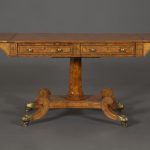
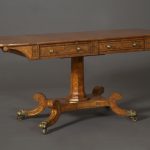
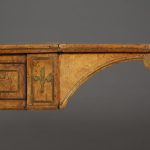
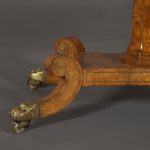
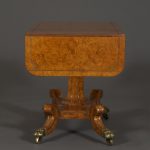
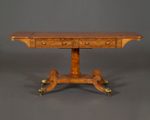
Comments are closed.